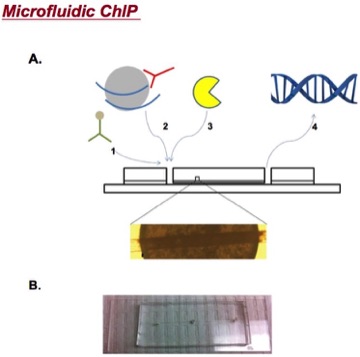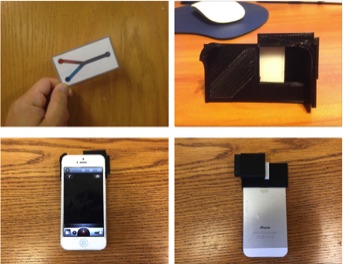Microfluidics-based Assays
Microfluidic chromatin immunoprecipitation (ChIP) for analyzing histone modifications in neonatal mouse brains
Smart device-based systems for in-situ chemical/biological analysis
Microreactor technology
Open-source instrumentation


Figure 1. (Left) Chromatin immunoprecipitation (ChIP) procedures. (Right) Microfluidic ChIP. Schematic diagram of performing ChIP assays in the microreactor: 1. The microreactor is packed with functionalized magnetic beads. 2. Fragmented chromatin and the histone antibody are loaded into the microreactor. 3. Proteinase K is added to remove histone proteins. 4. Eluted DNA is purified and analyzed by PCR amplification. B. Image of the microreactor with a rare earth magnet at the center.
- In eukaryotic cells, genomic DNA is packaged with histone proteins, forming chromatin. Histone modifications occurring on specific genomic loci have been linked to regulation of chromatin structure and thus gene transcription.
- Chromatin immunoprecipitation (ChIP) has become the primary technique used to identify the genomic regions containing targeted histone modifications (Figure 1). Conventional tube-based ChIP assays are time- and labor-consuming and require a large amount of samples, reagents, and multiple tedious steps.
- To solve these problems, we are developing miniaturized ChIP assays on a microfluidic platform by creating a PDMS microreactor packed with functionalized magnetic microbeads. This device has been used to explore potential applications of microfluidics-based ChIP assays to analyze histone modifications occurring at the promoters of selective genes expressed in the developing mouse brain.
- Integration of paper microfluidic devices, 3D-printed attachments, and a smart phone
- Determine the nitrite concentration in water samples from Port of Los Angeles and Port of Long Beach using a colorimetric assay
- Applicable to emerging contaminants, such as pharmaceuticals, illicit drugs, and personal care products, with an appropriate combination of chemistry and microchip design

Ref.: J. Environ. Monit., 2002, 4, 465–471


Design and construct integrated, microfluidics-based systems for rapid, high-yield flow chemistry
- Sample reaction: Synthesis of bicyclic lactams for pharmaceutical applications
- Sample reaction: Synthesis of alginate microbeads
- Fabrication of micro-/mini- reactors via 3D printing using alternative materials, such as engineering plastics and clay
Ref.: Tetrahedron Letters, 54 (2013) 562-567






Design and construct instruments for research and education using 3D printing and open-source software and electronics


Open-source spectrophotometer constructed with an Aduino board and 3D-printed enclosure.
